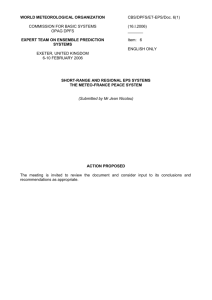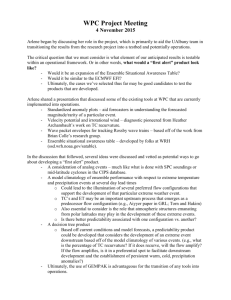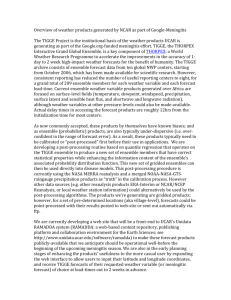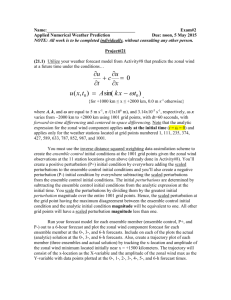Kalnay, 2003 - RTC, Regional Training Centre
advertisement
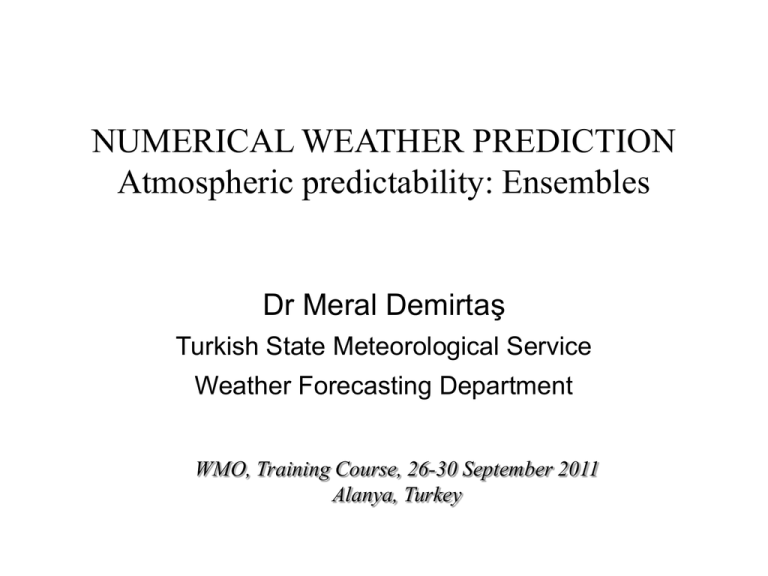
NUMERICAL WEATHER PREDICTION Atmospheric predictability: Ensembles Dr Meral Demirtaş Turkish State Meteorological Service Weather Forecasting Department WMO, Training Course, 26-30 September 2011 Alanya, Turkey Outline • Introduction • How predictable is the atmosphere? • Why do we need ensembles? • What are the commonly used ensemble techniques? A Schematic illustration of ensemble prediction. (Kalnay, 2003) Predictability depends on how stable the dynamical systems are…. – Unstable systems have finite predictability (chaos) – Stable systems are infinitely predictable (Kalnay, 2003) What may lead to forecast error growth? An NWP system may lose skill over the time because of the growth of errors in the initial conditions (initial uncertainties) and also numerical models describe the laws of physics only approximately -which causes model uncertainties. Predictability is flow dependent. The Lorenz Chaos Model (1963) illustrates this view: (ii) (i) (iii) (Palmer et al., 2007) The prototypical Lorenz model of loworder chaos, showing that in a nonlinear system, predictability is flow dependent. (i) A forecast with high probability (stable), (ii) forecast with moderate predictability (less stable), (iii) forecast with low predictability (unstable). Initial conditions and the butterfly effect In chaos theory, the butterfly effect is the sensitive dependence on initial conditions; where a small change at one place in a nonlinear system can result in large differences to a later state. An attractor is a set towards which a dynamical system evolves over time. That is, points that get close enough to the attractor remain close even if slightly disturbed. Lorenz Chaos Model (1963) in a nutshell Lorenz (1963) introduced a 3variable model that is prototypical example of chaos theory. The system is non-linear (it contains products of the dependent variables) but autonomous (the coefficients are time-independent). The solution obtained by integrating the differential equations in time is called a flow. A plot of the trajectory of Lorenz system for values: ρ=28, σ=10, β=8/3 Lorenz Chaos Model (1963) Equations: where σ is called the Prandtl number and ρ is called the Rayleigh number. All σ, ρ, β > 0, but usually σ=10, β=8/3 and ρ is varied. The parameters σ, ρ, β are kept constant within an integration, but they can be changed to create a family of solutions of the dynamical system defined by the differential equations. The particular parameter values chosen by Lorenz (1963) were: σ=10, β=8/3 and ρ=28 -which result in chaotic solutions (sensitively dependent on the initial conditions). A Schematic illustration of the evolution of a small spherical volume in phase space in a bounded dissipative system (Kalnay, 2003) The probabilistic approach to NWP: ensemble prediction The predictability problem may be explained in terms of the time evolution of an appropriate probability density function (PDF). Ensemble prediction based on a finite number of deterministic integration seems to be a feasible method to predict the PDF beyond the range of linear growth. Ensemble prediction basics • An Ensemble Prediction System is a set of integrations of one or several NWP models that differ in their initial states and/or in their configurations and boundary conditions. • Ensemble prediction is an attempt to estimate the non-linear time evolution of the forecast error probability distribution function (PDF). • With Ensemble forecast, it is possible to evaluate, express and forecast uncertainty. Some Ensemble Prediction Techniques • Singular Vectors (SVs) Singular vectors are the linear perturbations of a control forecast that grow fastest within a certain time interval (Lorenz, 1965), known as “optimization period”, using a specific norm to measure their size. • Bred Vectors (BVs) Breeding is a nonlinear generalization of the method to obtain leading Lyapunov vectors, which are the sustained fastest growing perturbations. Bred Vectors (like leading Lyapunov Vectors) are independent of the norm and represent the shapes of the instabilities growing upon the evolving flow. • Multiple data assimilation ensembles (EnKF, ETKF, LETKF) • Accounting for model related uncertainties (see the next slide) • Multi-model/multi-system ensembles Main strategies practiced for sampling • Prioritized sampling: sample leading sources of forecast error (prioritize). Rationale: Considering complexity and high dimensionality of a forecasting system properly sampling the leading sources of errors is crucial. Rank sources, prioritize, optimize sampling: growing components will dominate forecast error growth. Following this strategy; ECMWF have been employing “singular vectors” and some places uses “bred vectors”. • All-inclusive Sampling: sample all sources of forecast errors (uncertainties). Perturb any input (observations, boundary fields, …), any model parameter that is not perfectly known, and etc. Singular Vectors (1) • Perturbations pointing along different axes in the phase-space of the system are characterized by different amplification rates. As a consequence, the initial PDF is stretched principally along directions of maximum growth. • The component of an initial perturbation pointing along a direction of maximum growth amplifies more than components pointing along other directions. Singular Vectors (2) At ECMWF, maximum growth is measured in terms of total energy. A perturbation time evolution is linearly approximated: The adjoint of the tangent forward propagator with respect to the totalenergy norm is defined, and the singular vectors, i.e. the fastest growing perturbations, are computed by solving an eigenvalue problem: Breeding Vectors (1) When there is an instability, all perturbations converge towards the fastest growing perturbation (Leading Lyapunov Vector, LLV). The LLV may be computed by applying the linear tangent model on each perturbation of the nonlinear trajectory random initial. A schematic illustration of how all perturbations will converge towards the Leading Lyapunov Vector, LLV (Kalnay, 2003) Breeding Vectors (2) • Breeding: Grow naturally unstable perturbations. It is a simple generalization of Lyapunov vectors, for finite time, finite amplitude. • Breeding is simply running the nonlinear model a second time, starting from perturbed initial conditions, rescaling the perturbation periodically. Two tuning parameters: rescaling amplitude and rescaling interval. Local breeding growth rate: Breeding Vectors (3) The breeding cycle has been designed to mimic the analysis cycle. Each BV is computed by: (i) adding a random perturbation to the starting analysis, (ii) evolving it for 24-hours (soon to 6), (iii) rescaling it, and then repeat steps (ii-iii). BVs are grown non-linearly at full model resolution. All-inclusive (Canadian approach) • Observational errors (random perturbations); • Imperfect boundary conditions (perturbed surface fields); • Model errors (different parameterizations and random error component added to the initial perturbations). Ensemble spread: Good and Bad… An ensemble forecast starts from initial perturbations to the analysis. In a good ensemble “truth” looks like a member of the ensemble The initial perturbations should reflect the analysis “errors of the day”. Kalnay, 2003 Sources of Uncertainties in an NWP System • Uncertainties in initial conditions • Uncertainties in Boundary Conditions • Uncertainties in the NWP models Uncertainties in initial conditions • Measurement errors inherent to the instruments. • Improperly calibrated instruments. - Systematic errors (bias) - Random errors • Incorrect registration of observations. • Data assimilation errors: - Imperfect data quality control. - Deficiencies in trial fields –the trial fields are usually 6-h model forecasts. - Unrepresentative observations and model error statistics. - Deficiencies in the data assimilation scheme • Data coding and transmission errors. • Lack of coverage –incomplete information. • Representativeness error: - Ideally an observing system should provide information on all model variables, at each initial time, representative at the model scale and on the model grid. - Model unresolved scales are sampled by observations. Uncertainties in Boundary Conditions Another uncertainty lies in the assignment of values for key variables at the bottom and lateral boundaries of an NWP model. Bottom boundary values that might be perturbed include: • Sea-surface temperatures (SSTs) • Soil moisture, snow cover, roughness length, vegetation properties • Prescribed boundary conditions (e.g., vegetation or soil type) Uncertainties in Bottom Boundary Conditions Ocean related parameters Land related parameters Tropical Pacific SST Mountain /No-Mountain Arabian Sea SST Forest /No-Forest (Deforestation) North Pacific SST Surface Albedo (Desertification) Tropical Atlantic SST Soil Wetness North Atlantic SST Surface Roughness Sea Ice Vegetation Global SST (MIPs) Snow Cover Uncertainties in the NWP models • • • • • • • • • Space and time truncation –resolution related, Dynamics formulation, Approximations due to numeric, Effects of unresolved physical processes, Physics parameterization, Closure assumptions, Lack of full understanding of physics of the atmosphere, Coding errors, Model jumpiness –higher resolution may increase model jumpiness, Accounting for model uncertainty Stochastic Physics: Perturbations (which may be formulated with spatial/temporal structures or other dependencies) to state variables’ tendency during model integration. Stochastic Backscatter: Return dissipated energy via scale-dependent perturbations to wind field. Random Parameters: Random perturbations to physics parameters (e.g., entrainment rate), which may be fixed prior to model integration or varied during model integration. Perturbed Surface Parameters: Perturbations to surface temperature, albedo, roughness length, etc., which may be fixed before model integration or varied during model integration Stochastic Parameterizations: Explicit modeling of the stochastic nature of subgrid-scale processes Coupling to Ocean/LSM Ensemble: Explicit modeling of the considerable uncertainty from the surface boundary TIGGE (the THORPEX Interactive Grand Global Ensemble eXperiment) It is a framework for international collaboration in development and testing of ensemble prediction systems. Key objectives are: • Enhance collaboration on predictability and ensemble prediction, • Foster the development of new methods of combining ensembles from different sources and correcting systematic errors (biases, spread over-/underestimation), • Help understanding the feasibility of interactive ensemble system responding dynamically to changing uncertainty (including use of adaptive observing, variable ensemble size, on-demand regional ensembles). TIGGE EPS framework • Globally; 10 operational global, medium-range ensemble systems, BMRC, CMA, CPTEC, ECMWF, FNMOC, JMA, KMA, MSC, NCEP and UKMO, with horizontal resolution ranging from T62 to TL639 (~32km), and with forecast lead time ranging from 8 to 16 days. • Over Europe; 5 operational Limited-area EPSs, SRNWP-PEPS, COSMO-LEPS, INM, LAMEPS and PEACE, that produce daily ~50 forecasts with horizontal resolution ranging from 7 to 25 km, and with forecast length ranging from 30 to 120 hours. Six further LEPSs: UKMO, DMI, HMS, MeteoSwiss, SAR, PIED-SE • Over North-America; there is 1 operational Limited-area EPSs (NCEPSREF) that produces daily 30 forecasts with horizontal resolution of 32 km, and a 63-hour forecast length. Plus Canada’s (MSC) Ensemble Prediction System. • Over Australia; BMRC is testing a 16-member, 0.5 degree resolution, 72-hour LEPS. Detailed the TIGGE ensembles info Acknowledgements: Thanks to documents/images of ECMWF, E. Kalnay (UMD) and various others that provided excellent starting point for this talk! Thanks for attending….
